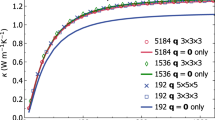Abstract
A detailed study of ultrasonic relaxation in the entire vitreous range of the glass system MoO3-P2O5 (0 to 83 mol% MoO3) is presented. Pulse echo techniques were employed in the frequency range 15 to 135 MHz and temperature range 4 to 300 K. Ultrasonic absorption peaks were observed at various temperatures between 74 and 128 K depending upon glass composition and operating frequency. The composition dependence of the position and overall shape of the loss peaks was analysed in terms of an assumed loss of the standard linear solid type, with low dispersion, and a broad distribution of Arrhenius-type relaxation times with temperature-independent relaxation strengths (two-well formalism with a broad distribution of asymmetries). After a brief review of two-well formalism, a simple central force model of the microscopic origins of two-well systems is presented, to demonstrate that (in contrast to what has often been assumed previously) there is no need to postulate bond directionality effects to account for “acoustically active” two-well systems in glassy materials. Also given is a quantitative model of the deformation potential arising in phenomenological models of acoustic loss produced by two-well systems. The shape of the loss peaks (i.e. the shape of the relaxation spectra), and the mean activation energy determined from the frequency dependence of the loss-peak temperature (V p), are both strongly composition-sensitive. Furthermore, they are found to correlate with the elastic properties of the glass system and the assumed bond force constants. The conclusion thus arrived at is that the acoustic loss is a property of the vitreous network as a whole rather than due to a second-order effect like the presence of dangling bonds or polar groups, or to network holes etc. Finally a microscopic phenomenological model is developed to account for the composition dependence of the observations. In particular, semi-theoretical formulae are used to expressV p and the fractional number of two-well systems per oxygen atom,N, as a function of the bulk modulus and a mean cation-anion stretching force constant. Considerable success was thereby achieved in explaining the contrasting behaviour ofV p andN.
Similar content being viewed by others
References
C. A. Maynell, G. A. Saunders andS. Scholes,J. Non-Cryst. Solids 12 (1973) 271.
J. Jäckle, L. Piche, W. Arnold andS. Hunklinger,ibid. 20 (1976) 365.
K. S. Gilroy andW. A. Phillips,Phil. Mag. B. 43 (1981) 735.
O. L. Anderson andH. E. Bommel,J. Amer. Ceram. Soc. 38 (1955) 125.
R. E. Strakna andH. T. Savage,J. Appl. Phys. 35 (1964) 1445.
C. A. Maynell andG. A. Saunders,Solid State Commun. 11 (1972) 1345.
R. Janoschek, in “The Hydrogen Bond”, edited by P. Schuster, G. Zundel and S. Sandorfly (North-Holland, Amsterdam, 1976) p. 194.
W. P. Kraemer andG. H. F. Diercksen,Chem. Phys. Lett. 5 (1970) 463.
J. M. Farley andG. A. Saunders,J. Non-Cryst. Solids 18 (1975) 417.
M. R. Vukevich,ibid. 11 (1972) 25.
R. E. Strakna,Phys. Rev. 123 (1961) 2020.
R. L. Mozzi andB. E. Warren,J. Appl. Crystallogr. 2 (1969) 164.
N. D. Patel andB. Bridge,Phys. Chem. Glasses 24 (1983) 130.
B. Bridge andN. D. Patel,J. Mater. Sci. 21 (1986) 1187.
J. T. Krause andC. R. Kurkjian,J. Amer. Ceram. Soc. 49 (1966) 134 and51 (1968) 226.
B. Bridge, N. D. Patel andD. N. Waters,Phys. Status Solidi 77 (1983) 655.
B. Bridge andA. A. Higazy,Phys. Chem. Glasses 27 (1986) 1.
A. A. Higazy, PhD thesis, Brunel University (1984).
Author information
Authors and Affiliations
Rights and permissions
About this article
Cite this article
Bridge, B., Patel, N.D. Ultrasonic relaxation studies of the vitreous system Mo-P-O in the temperature range 4 to 300 K. J Mater Sci 21, 3783–3800 (1986). https://doi.org/10.1007/BF02431613
Received:
Accepted:
Issue Date:
DOI: https://doi.org/10.1007/BF02431613




